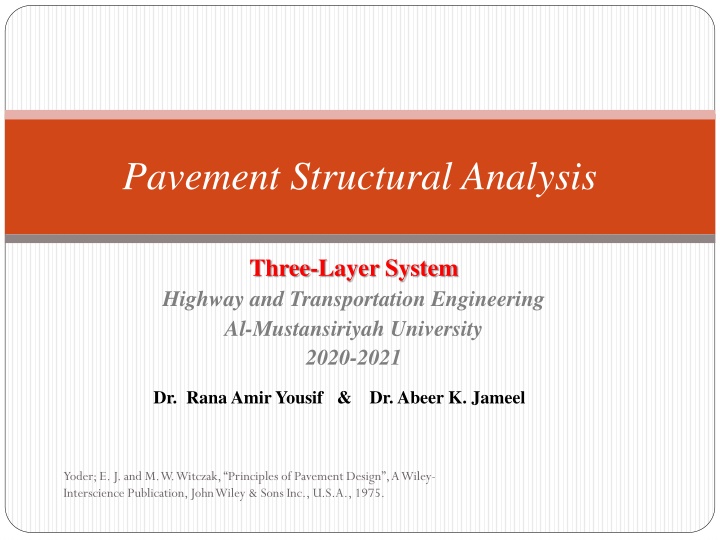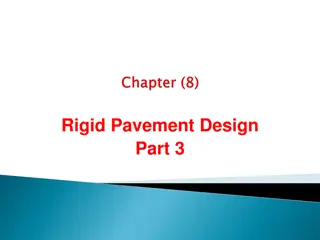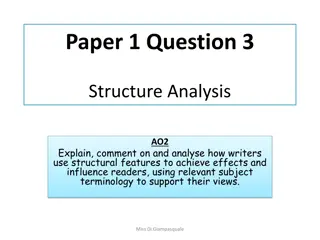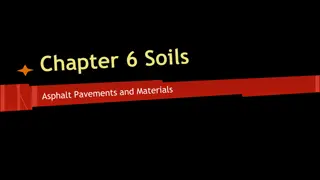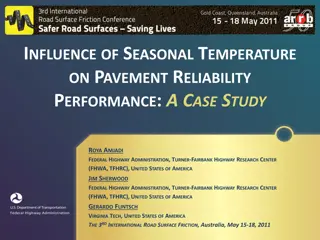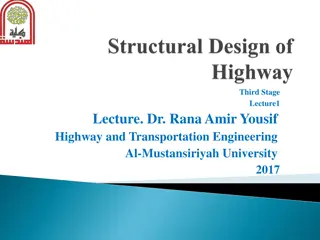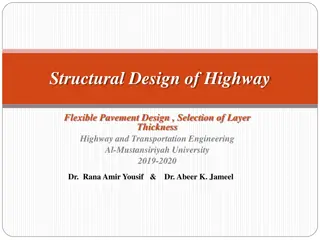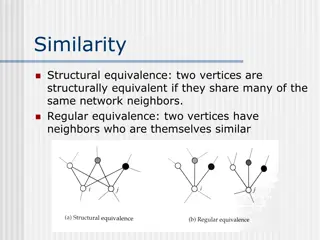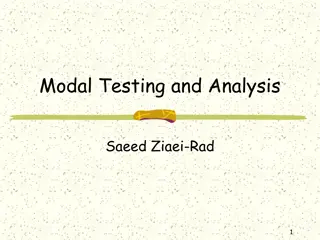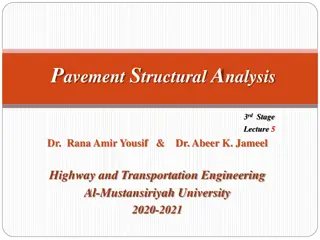Pavement Structural Analysis
The three-layer system in pavement structural analysis, as per Yoder & Witczak's Principles of Pavement Design, includes the top bituminous layer, base and subbase courses, and sub-grade. Stresses at interfaces, rationale, and tables for stress determination are explored.
Download Presentation

Please find below an Image/Link to download the presentation.
The content on the website is provided AS IS for your information and personal use only. It may not be sold, licensed, or shared on other websites without obtaining consent from the author.If you encounter any issues during the download, it is possible that the publisher has removed the file from their server.
You are allowed to download the files provided on this website for personal or commercial use, subject to the condition that they are used lawfully. All files are the property of their respective owners.
The content on the website is provided AS IS for your information and personal use only. It may not be sold, licensed, or shared on other websites without obtaining consent from the author.
E N D
Presentation Transcript
Pavement Structural Analysis Three-Layer System Highway and Transportation Engineering Al-Mustansiriyah University 2020-2021 Dr. Rana Amir Yousif & Dr. Abeer K. Jameel Yoder; E. J. and M. W. Witczak, Principles of Pavement Design , A Wiley- Interscience Publication, John Wiley & Sons Inc., U.S.A., 1975.
References Nicholas J. Garber and Lester A. Hoel. Traffic and Highway Engineering , Fourth Edition. Yoder; E. J. and M. W. Witczak, Principles of Pavement Design , A Wiley- Interscience Publication, John Wiley & Sons Inc., U.S.A., 1975. Yaug H. Huang, Pavement Analysis and Design , Prentic Hall Inc., U.S.A., 1993. AASHTO Guide for Design of Pavement Structures 1993 , AASHTO, American Association of State Highway and Transportation Officials, U.S.A., 1993. Oglesby Clarkson H., HighwayEngineering , John Wiley & Sons Inc., U.S.A., 1975. Yoder; E. J. and M. W. Witczak, Principles of Pavement Design , A Wiley- Interscience Publication, John Wiley & Sons Inc., U.S.A., 1975.
Three-Layer Systems With quick computational facilities available, the analysis of three or more layers is no more a difficult task. The three-layer system can be conceived as follows: 1. Top layer, representing all the bituminous layers taken together, 2. Second layer, representing the unbound base and subbase courses, and 3. Third layer, representing the sub-grade. Yoder; E. J. and M. W. Witczak, Principles of Pavement Design , A Wiley- Interscience Publication, John Wiley & Sons Inc., U.S.A., 1975.
Three-Layer Systems Figure 2-29 shows a three-layer system and the stresses at the interfaces on the axis of symmetry. Yoder; E. J. and M. W. Witczak, Principles of Pavement Design , A Wiley- Interscience Publication, John Wiley & Sons Inc., U.S.A., 1975.
Three-Layer Systems At the axis of symmetry, tangential and radial stresses are identical and the shear stress is equal to 0. Yoder; E. J. and M. W. Witczak, Principles of Pavement Design , A Wiley- Interscience Publication, John Wiley & Sons Inc., U.S.A., 1975.
Three-Layer Systems Jones has developed a series of tables for determining the stresses in a three-layer system for the following dimensionless parameters Jones' Tables: The stresses in a three-layer system depend on the ratios k1, k2, A, and H, defined as Yoder; E. J. and M. W. Witczak, Principles of Pavement Design , A Wiley- Interscience Publication, John Wiley & Sons Inc., U.S.A., 1975.
Three-Layer Systems Once the stresses at the interfaces are calculated, strains can be computed from the equations of strains. Yoder; E. J. and M. W. Witczak, Principles of Pavement Design , A Wiley- Interscience Publication, John Wiley & Sons Inc., U.S.A., 1975.
Yoder; E. J. and M. W. Witczak, Principles of Pavement Design, A Wiley- Interscience Publication, John Wiley & Sons Inc., U.S.A., 1975.
Yoder; E. J. and M. W. Witczak, Principles of Pavement Design, A Wiley- Interscience Publication, John Wiley & Sons Inc., U.S.A., 1975.
